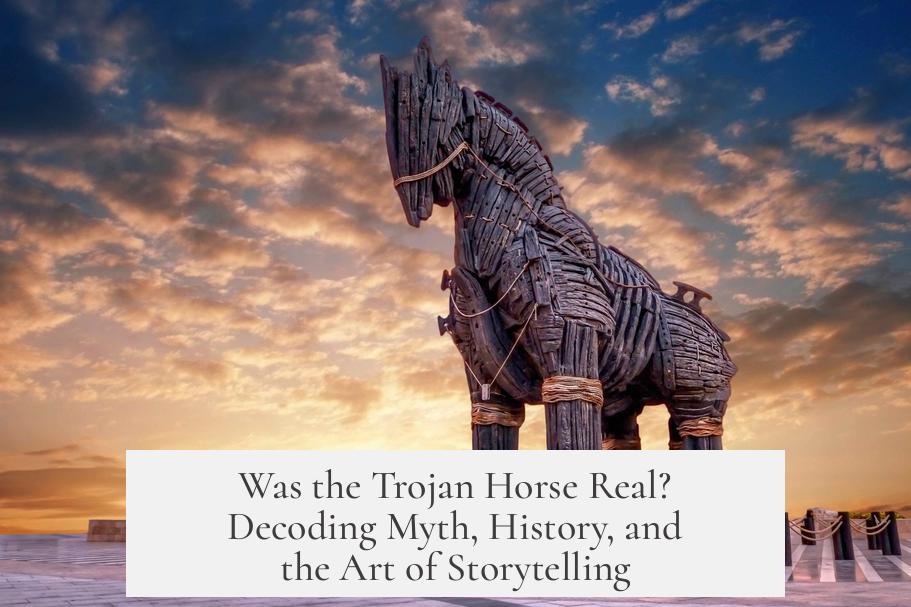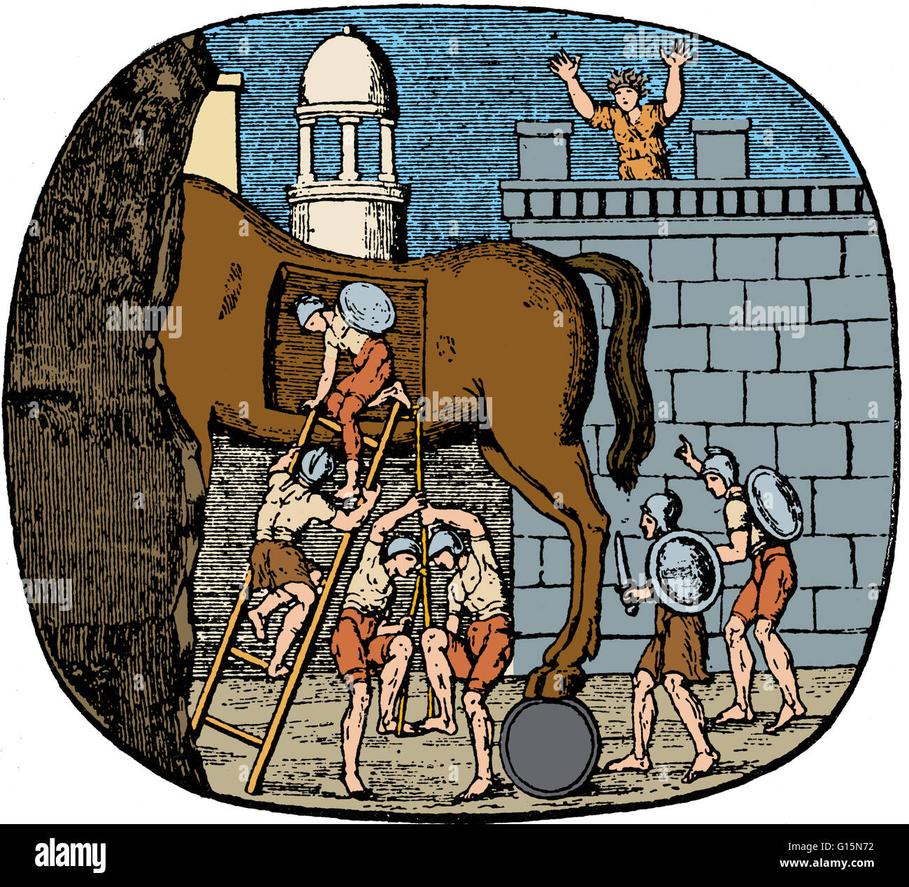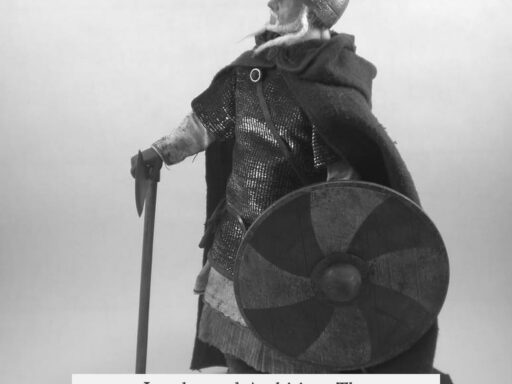The Trojan Horse was most likely not a real, physical object but rather a legend or symbolic story derived from ancient events and cultural storytelling. Troy itself existed, as archaeological discoveries at Hisarlik in modern Turkey confirm. The city’s ruins show damage circa 1275-1260 BCE, consistent with a conflict period that could represent the Trojan War. However, there is no direct evidence that a large wooden horse, used as a stealth tactic to collapse Troy’s defenses, ever existed.
Heinrich Schliemann’s 1873 excavation brought Troy from myth to reality, verifying the city’s historical status. Archaeologists agree Troy faced multiple attacks, yet nothing confirms the famous horse episode beyond literary accounts, primarily Homer’s Iliad. The story’s vivid nature and narrative value may explain its endurance, but it aligns more with allegory than literal history.
Scholars wrestle with the horse’s nature. Some propose it stands for a metaphorical device rather than a wooden structure. One popular theory interprets the “Trojan Horse” as a symbol for a natural disaster, like an earthquake—Poseidon’s domain in Greek mythology—which might explain the city’s debilitated walls in the relevant era.
- Another theory suggests the horse was a ship bearing a horse-shaped figurehead, a common motif on ancient vessels. Homer’s original Greek may have been mistranslated, turning what was a naval reference into a literal siege engine.
- A further suggestion views the horse as a battering ram disguised in poetic form, imitating a siege tool unfamiliar to Homer’s audience and expressed through metaphorical imagery.
Despite the lack of firm evidence for a wooden horse, the story conveys significant themes about warfare and deception valued by ancient Greeks. The phrase “Trojan Horse” persists worldwide, symbolizing cunning tricks and hidden threats centuries after the tale was first told.
The narrative’s plausibility aids its longstanding appeal. Greeks likely regarded leaving gifts or trophies at the city gates as typical post-conflict behavior. This detail adds authenticity, though practical issues challenge the horse’s literal credibility—such as whether Troy’s gates could admit a massive wooden figure or why defenders accepted such an obvious gift without suspicion.
Alternative historical and literary interpretations abound. Some modern authors reimagine the horse as a disguised military ruse, such as Trojan cavalry imitating captured soldiers to sneak inside. Other interpretations suggest smaller-scale acts of sabotage, where a handful of attackers infiltrated the city by using gifts or subterfuge, later exaggerated into the giant horse legend.
The origins of the Trojan Horse story span nearly a millennium after the supposed events. References appear much later, in the 4th or 5th century BCE, far from the 12th or 13th century BCE war. This time gap leads many historians to treat the horse episode as Homer’s poetic invention, comparable to other mythic elements rather than a verified event.
In sum, Troy was a real city, and a war likely occurred. The Trojan Horse, however, remains a powerful mythical motif. It illustrates ancient values around strategy and deceit rather than a documentary reality.
| Aspect | Evidence/Interpretation |
|---|---|
| Existence of Troy | Confirmed by archaeological digs at Hisarlik |
| War and Damage | Walls show damage circa 1275-1260 BCE; cause uncertain |
| Trojan Horse Physical Reality | No solid archaeological evidence; likely legend |
| Metaphorical Theories | Earthquake, ship figurehead, siege device |
| Cultural Impact | Story symbolizes deception; phrase used globally today |
- Troy was a real city involved in multiple conflicts during the Late Bronze Age.
- No concrete proof exists that the Trojan Horse was a giant wooden structure or siege device.
- The horse may symbolize an earthquake or represent a ship’s figurehead, reflecting mistranslations or metaphor.
- The story’s survival shows its importance as a cultural symbol of deception and warfare strategy.
- The tale likely arose centuries after the war as poetic invention blending history and myth.
Was the Trojan Horse Real? Decoding Myth, History, and the Art of Storytelling

Was the Trojan Horse a real, giant wooden contraption that helped the Greeks win the Trojan War, or is it just a legendary tale passed down through millennia? The short answer: the horse itself was likely a legend, but the city of Troy was definitely real. Let’s dig deeper.
Imagine this: it’s around 1275-1260 BC, walls crash, warriors scream, and the fate of a grand city hinges on a clever trick. Or does it? The story of Troy and its infamous horse is one that has fascinated the world for centuries, yet separating myth from history is anything but straightforward.
The Reality of Troy: A City Anchored in History

First and foremost, Troy—the very city where the saga unfolded—is no fantasy. In 1873, Heinrich Schliemann, a determined German businessman turned archaeologist, unearthed the ruins of what is now Hisarlik in modern Turkey. This discovery aligned eerily well with Homer’s epic Iliad, offering strong evidence that a grand metropolis named Troy once thrived there.
But here’s the hitch. Archaeological digs reveal damage to the ancient walls of Troy around the time the legendary war is supposed to have occurred. Yet, experts can’t say for sure whether this destruction was due to warfare, natural disaster, or something totally different.
“Troy itself was certainly real,” says history, “and involved in conflicts aplenty.” But the Trojan Horse? That remains a matter steeped more in legend than hard evidence.
Peeling Back the Legend: What Do We Really Know About the Trojan Horse?

Despite centuries of fascination, no solid evidence has ever been found to prove the existence of the wooden horse described in Homer’s tale. Did the Greeks really build a huge hollow horse and sneak inside to sneak past Troy’s defenders? Maybe, maybe not.
Some historians propose that the concept of the horse is a clever metaphor rather than an actual physical object. Could it represent some more general form of trickery, a strategic deception during the siege? The truth may be lost beneath layers of myth and time.
Intriguingly, one popular theory connects the horse to natural phenomena—namely, earthquakes. Poseidon, the god of the sea, was also the deity behind earthquakes in Greek mythology. It’s been suggested the “Trojan Horse” might have been a poetic way to describe an earthquake (sometimes called Poseidon’s horses) that weakened Troy’s walls, allowing attackers to enter.
Another fascinating interpretation arises from fresh translations of Homer’s texts by 21st-century scholars. They suggest that the “horse” might not have been a giant wooden sculpture but perhaps a ship bearing a horse-shaped figurehead—a common motif on ancient vessels. Archaeologists have indeed found fragments of horse carvings on ship figureheads. Could Homer’s Trojan Horse have been nautical rather than architectural?
Additionally, some scholars hypothesize that the horse was actually a battering ram disguised symbolically as a horse, a siege device almost unheard of then. Imagine trying to explain that to someone unfamiliar with siege techniques. Would that have sounded plausible enough to pass down as legend?
Why the Trojan Horse Story Has Endured

Regardless of the horse’s physical reality, one thing is clear—the story carries immense cultural and symbolic weight. The notion of a “trojan horse” has permeated our language and thinking so thoroughly that everyone knows the phrase, even thousands of years later.
It captures something vital about Greek values regarding warfare, cunning, and deceit. The myth resonates because it discusses cleverness overcoming brute strength, a narrative that many cultures appreciate and retell endlessly.
It’s a symbol for subterfuge, now used to describe sneaky tactics in computing, politics, and everyday surprises. The myth’s endurance is a testament not simply to historical fact, but to the power of storytelling itself.
But How Credible Is the Story? Can We Believe the Trick Worked?

The Trojan Horse story hits a sweet spot. The premise—a giant wooden gift left outside city walls, accepted by the defeated Trojans—sounds plausible to ancient audiences. Leaving trophies or supplications to gods was familiar warfare behavior, so the setup seems reasonable.
Yet, this raises some big “wait, what?” questions. If a massive wooden horse suddenly appeared, wouldn’t the Trojans have been suspicious? Why bring something that large inside at all? Why not burn it or destroy it? A horse tall enough to hide warriors inside would have to be gigantic. Were Troy’s gates even tall or wide enough to fit it?
These doubts suggest the story may have stretched credibility even for contemporary audiences, perhaps for dramatic effect. The likelihood that such a ruse worked exactly as Homer described is very low.
Alternative Theories and Twists on the Trojan Horse Tale

Not all historical enthusiasts dismiss the story entirely. Writer David Gemmell, in his Troy series, offers a clever reimagining where the “horse” wasn’t a wooden statue but troops disguised as Trojan cavalry, gaining entry into the city through trust and trickery.
Other theories liken the Trojan Horse to universal mythic motifs, like the “chaos dragon,” symbolizing disorder unleashed upon a city. These abstract ideas hint that the horse might embody an archetype rather than an actual object.
Some suggest the horse was much smaller—perhaps a wooden horse-shaped sculpture gifted alongside wine and food. A drunken celebration might have led a spy or sympathizer to slip inside and open the gates from within, a practical twist away from the giant horse image.
Historically, leaving a “gift” concealing a hidden attacker isn’t far-fetched. Before Homer’s poem surfaced, it’s plausible that a small group of attackers hid inside a gift at the city gate to betray Troy from the inside—less poetic, but more believable.
The Problem with Time: Evidence Lost and Stories Changed
One major challenge is the immense passage of time. If the Trojan War happened in the 12th or 13th century BC, but the first written references to the horse only appear around the 4th or 5th century BC—sometimes 800 years later—there’s plenty of room for details to change. Oral traditions tend to exaggerate over centuries.
It’s difficult to prove events from so long ago, especially without physical evidence of the horse. Unless we stumble upon a massive wooden horse buried under ancient rubble—a discovery as unlikely as finding Icarus’ wings—the mystery will endure.
Some experts argue the Trojan Horse is purely a poetic invention, part of Homer’s broader myth-making, a story that blends fact and fantasy to convey cultural values and ideas about war, honor, and deception.
Can Myth and History Coexist?
So, was the Trojan Horse real? Based on current evidence, no clear archaeological proof confirms it was. Troy itself was real, enduring many conflicts, but the clever horse might be a brilliant metaphor or a storytelling device.
Does that make the story any less powerful? Not at all. The horse is a legendary icon teaching us about human ingenuity and trickery. It asks us to think: how do stories shape our understanding of history? Where do fact and fiction blend to create meaning?
Perhaps the real triumph isn’t the horse sneaking past walls, but the story sneaking across cultures and centuries to capture our imaginations.
Final Thoughts
The Trojan Horse stands as a monument to storytelling’s power. It provokes questions about history, language, and myth. Was it a giant sculpture? A ship? An earthquake metaphor? Or simply a tall tale to explain an ancient siege? The answer remains elusive—yet that’s part of its charm.
Next time you hear someone mention a “trojan horse,” remember this ancient debate. You’re invoking a story layered with history, legend, and human creativity—one that has shaped our language and thought for thousands of years.
In short, the horse might not be real, but its shadow looms large in the chronicles of human imagination.




